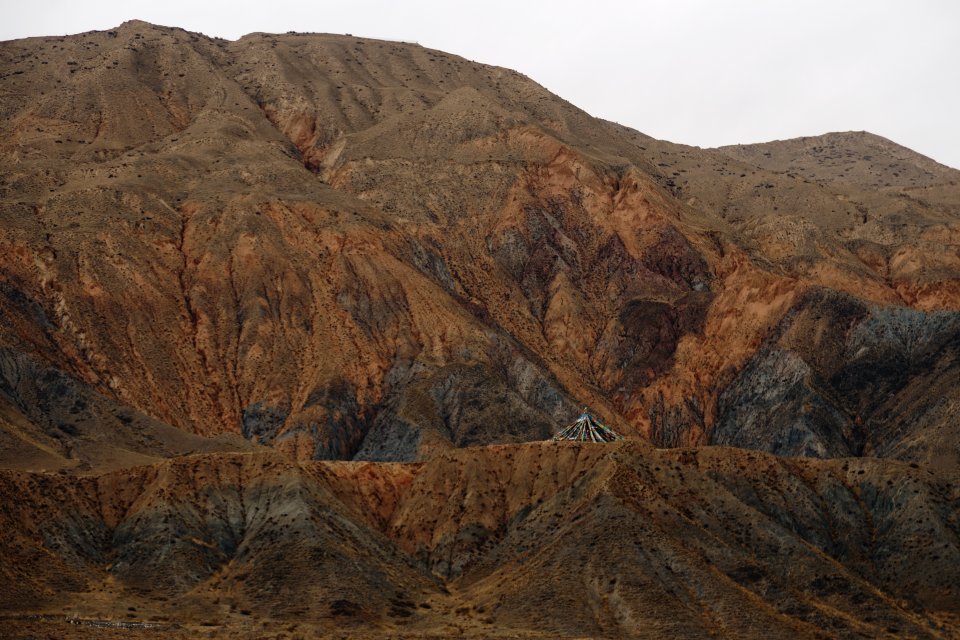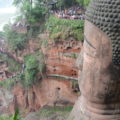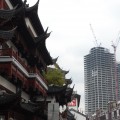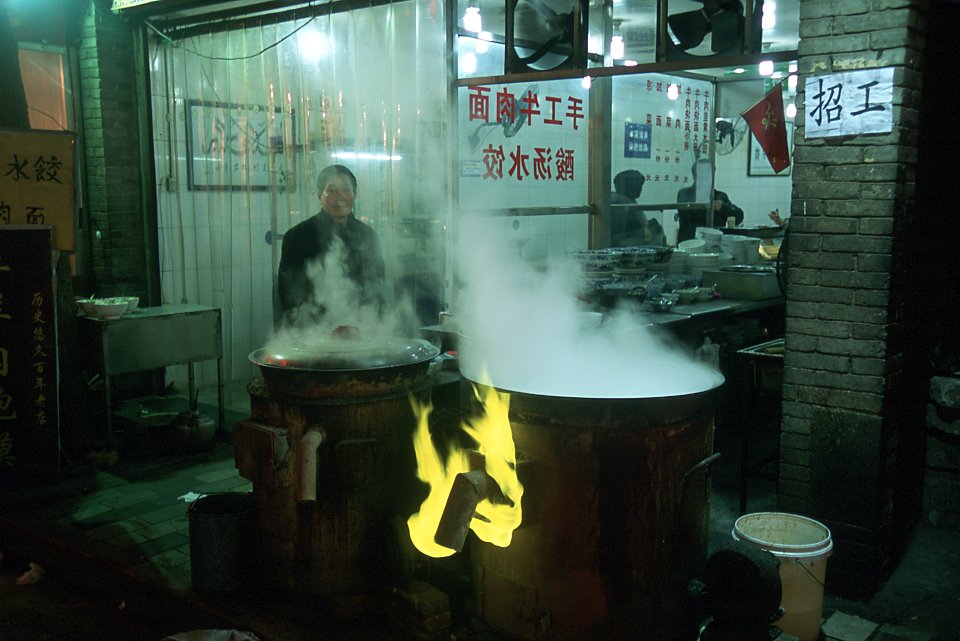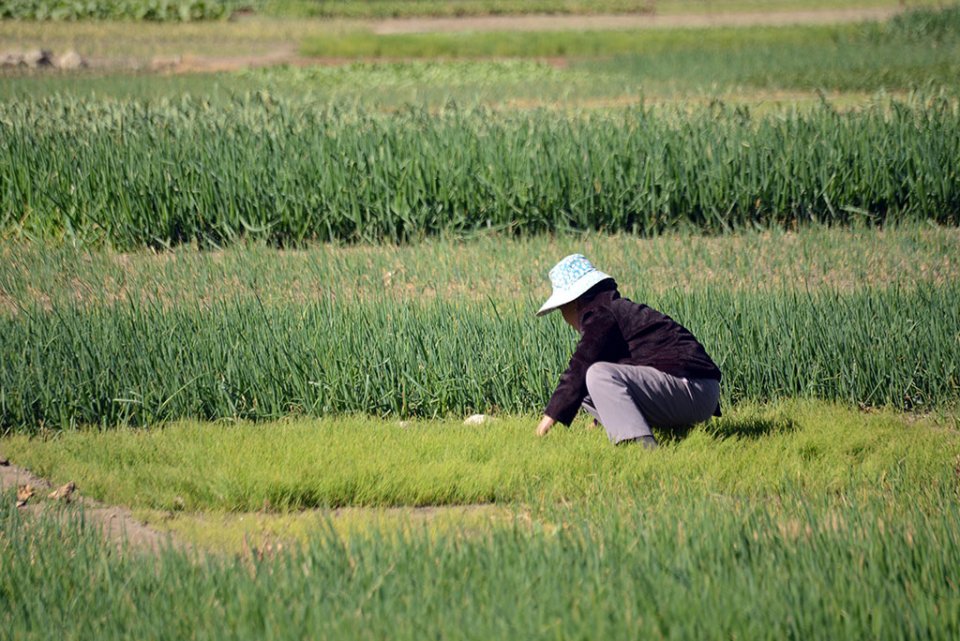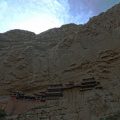En avril 2017, nous avons profité de congés nationaux (et de mon solde de congés à la fin de mon contrat) pour visiter les régions centrales de Chine, que nous n’avions pas encore eu l’occasion de voir.
Lanzhou
Lanzhou est le pivot des transports entre l’Est et l’Ouest de la Chine. Les seules attractions notables sont un temple à flanc de colline au bord du Fleuve Jaune et un petit temple reconverti en marché aux puces. Les petits restaurants de nouilles et de brochettes de viande sont légion, mais ils sont en rupture de stock très tôt dans la soirée !
Bingling Si
En sortant de Lanzhou, nous sommes frappés par les paysages de terre jaune à perte de vue, cliffs shaped in crumbly rock by long-vanished rivers, or by man – some hills evoke the rice terraces that thrive a thousand kilometers away. But here no cultures, not a tree, nor even a bush on the horizon.
A two-hour drive from Lanzhou through these desert landscapes, we arrive at a pier on a reservoir lake. It then takes an hour by speedboat (or five hours by slow boat) to reach Bingling Temple. Now isolated from the rest of the world by the reservoir, which adds to the solemnity of the place, this temple contains hundreds of Buddha statues in niches on the cliff, some of which are over a thousand years old. It was built and maintained by donations from Silk Road merchants..
Xiahe, Repkong and southern Gansu
Leaving Bingling Temple, we arrive at the end of a tunnel on the heights overlooking this same reservoir. The bright ocher color and deep blue of the water contrast with the monotonous yellow dominant in the region.
Southern Gansu is home to many minorities : going from Lanzhou to the Tibetan regions, we cross several Muslim autonomous districts where even the smallest village has its mosque. From one village to another, there is a great diversity of styles in the construction of mosques : chinese style, style ottoman, prayer room in Chinese style and minaret in Ottoman style or vice versa, there is something for everyone, and we can sense a certain religious tolerance (nevertheless it seems that, Since, this space of freedom closed).
After two hours of driving, here we are in Xiahe, small town which houses the Labrang temple, one of the most active outside Tibet.
The general atmosphere of fervor is impressive. Many pilgrims of Tibetan ethnicity make the trip there, often on foot. The ritual begins with rounds around the chörtens (stupas) clockwise, then by a stroll along the monastery walkway, always clockwise. The most fervent worshipers prostrate themselves every four steps, after having traveled for some several hundred kilometers in this way ! A little everywhere on the way, large prayer wheels are set in motion by pilgrims. The ambient fervor contrasts with the nonchalance of the monks, for some busy playing on their cell phones !
The next day, we set off towards the small town of Repkong. The road begins by rising gently into the mountains; on the outskirts, herds of yaks graze peacefully in the steppes. The road continues to rise, and therefore, the temperature drops proportionally until it approaches the fateful bar of zero degrees, and the first snowflakes to appear… Worried about potentially getting stuck in the snow in the middle of nowhere, I think of turning around when we see a chörten with its inevitable flags of all colors, which seems to mark the collar. This is indeed the case and once passed on the other side, the weather is clearing up little by little. A little further, we stop at a small gas station in front of a Tibetan temple; only, there doesn't seem to be a living soul on the horizon. After a few minutes, a man in monk's habit appears, and it is indeed the pump attendant; only, he only speaks the local Tibetan dialect. We still manage to make ourselves understood, the reason for our presence being quite obvious (refuel, in this case).
A little further, a herd of goats wanders on the road. On the outskirts, a few stables are scattered throughout the eternal landscape of yellowish earth dotted with only a few rare tufts of vegetation.
A few more kilometers further, the landscape changes into small canyons of red earth dug by erosion. A waterfall, exit from we don’t really know where given the general aridity of the region, is frozen in ice as if a local deity had cast a spell. A chörten placed in the middle of a valley, is surrounded by a few plots of crops. Here and there, some houses in traditional architecture appear, with small groups of men in monk's robes holding confabulations.
We finally arrive at Tongren (Repkong in Tibetan) at the end of the afternoon and in gloomy weather. At the entrance to the small town, a panel indicates several points of interest including one “fortress”. In fact, it is a village of small cob and wooden houses, also surrounded by a cob wall – the same yellow soil found throughout the region.
At the entrance to the city are the Wutun temples. “High” and “Bas”. Ici, no crowds of pilgrims although photos show that processions take place there, nous devions être les seuls visiteurs de la journée ou peu s’en faut. L’avantage est que nous avons pu avoir une visite guidée par un des moines, notamment des salles de prière habituellement fermées aux visiteurs dans les temples (mais les photos étaient malheureusement interdites).
Logées dans de grands bâtiments en bois soutenus par d’imposants piliers, les salles de prières sont peintes en rouge très foncé du sol au plafond. La seule ouverture sur l’extérieur est en général la porte frontale – souvent fermée par de grandes tentures, in front of which is a wall that shields evil spirits – or more prosaically to drafts. The faint glow of a few candles is enough to reveal the vivid colors of the agile placed all around the room, large paintings taking up the traditional themes of Buddhism with effigies sometimes benevolent sometimes evil with their features taken to the extreme. This temple is apparently famous for its tangkas painted by the monks, and has a large collection. Some even survived the Cultural Revolution thanks to Mao portraits painted on the back..
At the front of the prayer hall, stands a “altar” où l’on retrouve plusieurs statues, ainsi que les traditionnelles offrandes : des fruits, de la nourriture, des plantes, parfois de l’alcool. Et aussi, une photo du Dalaï Lama, cleverly arranged to only be visible very close to the altar.
The next day, the sun reappears and we set off towards the Rongwo temple on the other side of the town. On the street leading to the temple, many small shops offer religious articles : Buddha statuettes, prayer wheels… Buddhist version of certain streets of Lourdes. However, one also sells very good yogurts !
The abundant light projects us the play of colors of the buildings : the walls, or immaculate white, or ocher or sienna color, respond to the ubiquitous gold and primary colors of the woodwork.
In front of the entrance of some buildings, dozens of pairs of boots are waiting there, as if an entire regiment fled in socks. A little further, we perceive a great commotion and we approach the courtyard of a temple : more than a hundred monks are gathered and “debate” in small groups, standing or sitting cross-legged, supporting their words with big gestures and clapping their hands. Not far, a group of young children in monks' robes run past.
To Qinghai Lake
We set off for the shores of Qinghai Lake. On the road, we pass near the city of Xining (a big Chinese gray city that emerged in a few years like so many others, with its endlessly replicated building blocks).
To the west of Xining, the road winds through a mountainous pass; we see higher on the slope the railroad which rushes towards Tibet – completed in 2006 and the tallest in the world.
As we arrive on the set, the ripples of the mountains fade away. After a final pass, the lake appears to us like a Chinese watercolor with a foreground of unavoidable yellow earth, then the lake with its foam and a gradation of blues, and the white dusted mountains in the background.
In fact of foam, we realize as we approach that the shores are still largely covered by ice at the beginning of May ! Indeed, the lake is over 2000m above sea level and nothing holds back the heat.
Along the main road, we see tracks that look like bike paths. Nevertheless the huge dung indicates that it is not cyclists who use it, but the many herds of yaks around !
After a night there, we return to Xining to return the car then we take the fast train to Zhangye.
Zhangye
What attracts visitors to Zhangye, these are obviously the Zhangye Danxia or rainbow rocks. I admit that, having seen photos of the place on the internet which looked heavily retouched, I expected to be disappointed. Well, disappointed I was not, puisque bien que les couleurs ne soient pas aussi saturées que sur les photos qui circulent, le lieu est très beau et suffisamment inhabituel pour mériter le détour. Une aridité extrême – pas un buisson à l’horizon – qui laisse voir chaque pli, chaque strate de roche qui a pris une couleur différente des strates voisines. Un arc-en-ciel, mais au sol et non pas éphémère mais qui a mis des dizaines d’années à apparaître et qui sera encore là des dizaines d’années. Pour une fois, on pourra trouver des mérites au tourisme à la chinoise (on est déposé en bus d’un point de vue à l’autre, et il n’est bien évidemment pas question de s’écarter des chemins balisés), car le lieu ne supporterait pas d’être piétiné par des centaines de visiteurs tous les jours.
Autre lieu qui mérite le détour, le Mati Si ou Temple du Fer à cheval. On the road, nous dépassons de petits villages paysans, avec de petites maisons basses en torchis. Les cultures semblent s’élever difficilement dans les terres aux alentours. Quelques arbres ont pu prospérer aux abords des routes – fait suffisamment rare pour être rapporté.
Des galeries qui permettent de s’élever à flanc de falaise, des pavillons qui tiennent, on ne sait trop comment, au dessus du vide, et les indispensables fanions multicolores font de ce temple caché au fond d’une vallée perdue un petit joyau qui mérite bien le détour – même après avoir vu des dizaines d’autres temples !
Revenus au centre-ville, nous déjeunons au marché. Signe que nous sommes à un point de rencontre entre plusieurs civilisations, la cuisine ouïgour se fait de plus en plus présente : brochettes de viande épicée, soupe de nouilles au ragoût de mouton, petit chausson à la viande (roujiamô), riz frit, pain rond : tous les grands classiques que l’on retrouve dans le monde sous influence ou présence musulmane, dans un grand espace allant de Pékin jusqu’à Kazan (région du Tatarstan en Russie) en passant par l’Asie Centrale.
Une autre curiosité est le Bouddha allongé – paraît-il le plus grand du monde, presque quarante mètres. Contrairement aux représentations habituelles où Bouddha a un air jovial et apaisé, son expression est assez étrange. Je songe avec inquiétude à ce qui pourrait arriver si, comme dans l’épisode de Tintin en Égypte, la statue se réveillait de mauvaise humeur…
The next day, nous reprenons le train en direction de Jiayuguan. La ligne nouvelle à grande vitesse, achevée récemment pour relier Xi’An à la région à majorité musulmane du Xinjiang, longe la ligne classique à travers la plaine jaune.
Jiayuguan
Long the final frontier of the Chinese empire to the west and a garrison post on the Silk Road squeezed between two mountain ranges, Jiayuguan today is a greyish industrial city with its forest of blast furnaces spitting out everything they can, like the Fensch valley in the heyday.
The restored fort looks great with the high cob walls and guard towers. In good weather, the Qilianshan range make a great backdrop. Except that good weather we did not have, but we were treated to gray and rainy weather, and even a snow shower, which must be relatively rare in the region given the aridity…
A l’autre bout de la ville, une fortification restaurée (ou plutôt reconstruite) enjambe une rivière, chose assez rare dans les constructions chinoises. De là, une partie restaurée de la Grande Muraille grimpe sur les versants nus et escarpés, les tours d’observation couronnées de leurs créneaux sont postées à intervalles réguliers sur les crêtes.
Nous terminons notre visite par le site de l’extrémité ouest de la Grande Muraille. Construite avec les moyens locaux (torchis), cette section en plaine s’arrête brusquement au bord du fleuve. Le poste d’observation est posé au milieu du désert tel un gros pâté de sable, as if a giant's child had played with his bucket and left his work behind. You can still make out the ditch that ran along the outer part of the wall.
Back to the hotel, we pass through a park in the middle of which sits a vestige of a steelworks surrounded by lampposts with an outdated design, the whole curiously reminiscent of the artifacts displayed in public spaces in the former USSR in a now anachronistic proclamation of progress.
Practical aspects
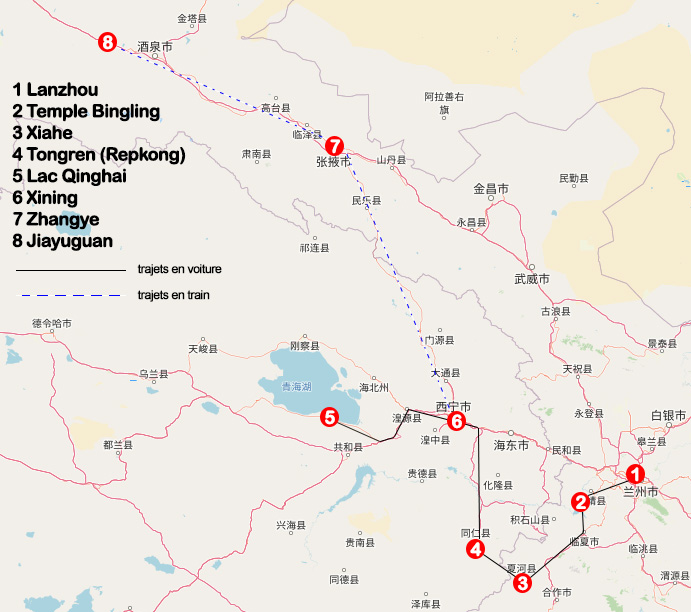
Transports :
We rented a car for convenience and to save time traveling., d’autant que nous étions partis lors de congés nationaux et les transports en commun sont habituellement pris d’assaut. Néanmoins, toutes ces destinations sont accessibles en transports en commun, sauf peut-être le lac Qinghai où il ne me semble pas avoir vu de bus.
La partie sud du Gansu n’est pas desservie par le train mais par un réseau du bus et minibus plus ou moins fréquents.
Zhangye et Jiayuguan sont desservis depuis Lanzhou et Xining par des trains rapides qui poursuivent leur route vers Dunhuang et le Xinjiang.
L’aéroport de Lanzhou est intensément desservi mais très éloigné du centre ville. Lors de notre passage, on cheminait près d’une heure sur des routes pas encore achevées, dans un taxi déglingué avec les valises qui dépassaient du coffre (un grand classique chinois).
Jiayuguan est desservi par un petit aéroport relié principalement à Lanzhou.
Hôtels :
Lanzhou : un hôtel affilié au réseau Ibis est situé au calme près de la principale rue piétonne.
Xiahe : Une adresse : le Nirvana Hôtel et Restaurant, tenu par une américaine et son mari tibétain (au style de Lemmy Kilmister à la sauce locale !). Savant mélange de style traditionnel et de confort occidental. Son restaurant sert également de bons (et parfois surprenants) plats tibétains.
Tongren : le Nuoerbang Lüyou Inn et sa décoration en style tibétain kitsch à souhait.
Restaurants :
Lanzhou : on trouve de nombreux restaurants et échoppes de nouilles autour de Zhangye Lu (la principale rue piétonne) et Zhongshan Lu.
Tongren : on trouve également de nombreux petits restaurants autour de la place centrale de la ville.
Zhangye : sur le marché principal, il y a de nombreux petits restaurant (en dur) et des petits stands de grillades.
